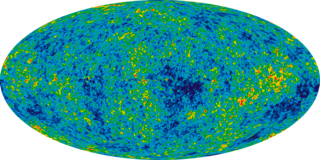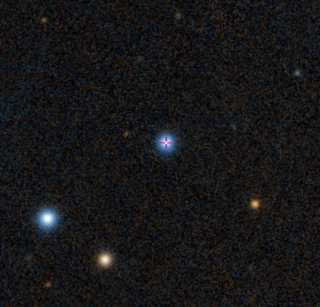Related Research Articles

A quasar is an extremely luminous active galactic nucleus (AGN). It is sometimes known as a quasi-stellar object, abbreviated QSO. The emission from an AGN is powered by a supermassive black hole with a mass ranging from millions to tens of billions of solar masses, surrounded by a gaseous accretion disc. Gas in the disc falling towards the black hole heats up and releases energy in the form of electromagnetic radiation. The radiant energy of quasars is enormous; the most powerful quasars have luminosities thousands of times greater than that of a galaxy such as the Milky Way. Quasars are usually categorized as a subclass of the more general category of AGN. The redshifts of quasars are of cosmological origin.

In the fields of Big Bang theory and cosmology, reionization is the process that caused electrically neutral atoms in the universe to reionize after the lapse of the "dark ages".
3C 191 is a quasar located in the constellation Cancer. It is located at redshift z = 1.95 and is hosted by an elliptical galaxy. The quasar contains a radio jet known to contain a high rotation measure with a thin shell configuration created in a form of wind inside the central regions.

3C 109 is a Seyfert galaxy located in the constellation Taurus. It is also a broad-line radio galaxy, classified as one of the most active polarized galaxies apart from blazars with quasar-like properties. The black hole in 3C 109 is said to have an estimated mass of 9.3 x 108 M○.

The Cloverleaf quasar is a bright, gravitationally lensed quasar. It receives its name because of gravitational lensing spitting the single quasar into four images.

NGC 3862 is an elliptical galaxy located 300 million light-years away in the constellation Leo. Discovered by astronomer William Herschel on April 27, 1785, NGC 3862 is an outlying member of the Leo Cluster.

III Zw 2 is a Seyfert 1 galaxy located in the Pisces constellation. It has a redshift of 0.089 and is notable as the first of its kind to exhibit a superluminal jet.

3C 345 is a blazar/flat spectrum radio quasar located in the constellation of Hercules. It is noted for hosting a superluminal jet and its variability in almost all wave bands.

PKS 0637-752 is a quasar located six billion light years in the constellation of Mensa. It is noted for having a bright and largest astrophysical jet at redshift of z = 0.651. Discovered by Einstein Observatory in 1980 through X-rays, PKS 0637-752 was the first celestial object to be observed by Chandra X-ray Observatory upon its commissioning in July 23, 1999.

IRAS 05189-2524 is a galaxy merger located in the constellation Lepus. It is located 603 million light-years away from the Solar System and has an approximate diameter of 75,000 light-years.

IRAS 09104+4109 is a galaxy located in the constellation Lynx. With a redshift of 0.440797, the light travel time for this galaxy, corresponds to 4.8 billion light-years from Earth. It is the brightest cluster galaxy in MACS J0913.7+4056 galaxy cluster and classified as a hyperluminous infrared galaxy.

4C +71.07 known as S5 0836+71, is a quasar located in the constellation Ursa Major. Based on its high redshift, the object is located 10.7 billion light-years away from Earth and such, classified as a blazar with a flat-spectrum radio source and features a radio jet.

PKS 0537-286, also known as QSO B0537-286, is a quasar located in the constellation Columba. With a redshift of 3.104, the object is located 11.4 billion light years away and belongs to the flat spectrum radio quasar blazar subclass (FSQR). It is one of the most luminous known high-redshift quasars.

PKS 0438-436, also known as PKS J0440-4333, is a quasar located in constellation Caelum. With a high redshift of 2.86, the object is located 11.2 billion light-years from Earth and is classified as a blazar due to its flat-spectrum radio source, (in terms of the flux density as with α < 0.5 and its optical polarization.

PKS 2126-158, also known as PKS 2126-15, is a quasar located in Capricornus. It has a redshift of 3.268000, which corresponds to the distance of 11.5 billion light years. It is classified as a gigahertz peaked-spectrum quasar (GPS) with a flat-spectrum radio source and a blazar, a type of active galaxy shooting an astrophysical jet towards Earth.

PKS 1402+044 is a quasar located in the constellation of Virgo. It has a redshift of 3.207, estimating the object to be located 11.3 billion light-years away from Earth.

PG 1543+489, also known as QSO B1544+4855 and PGC 2325245, is a quasar located in the constellation of Boötes. At the redshift of 0.399, the object is located 4.5 billion light-years away from Earth. It was first discovered in 1983, by researchers who presented 114 objects in the Palomar-Green bright quasar survey, as one of the best studied samples of active galactic nuclei (AGN).

PKS 0805-07 also known as PMN J0808-0751 and 4FGL J0808.2-0751, is a quasar located in the constellation of Monoceros. With a redshift of 1.83, light has taken at least 10 billion light-years to reach Earth.

SDSS J135646.10+102609.0 known as SDSS J1356+1026 and J1356+1026, is a low redshift quasar and galaxy merger located in the constellation of Boötes. It is located 1.85 billion light years from Earth. It is an ultraluminous inflared galaxy. It is considered radio-quiet with an unresolved radio source.

Markarian 1014 known as PG 0157+001 is a quasar located in the constellation Cetus. It is located at a distance of 2.47 billion light years from Earth and is classified as a Seyfert galaxy as well as an ultraluminous infrared galaxy (ULIRG).
References
- 1 2 3 4 5 "Query : 3C 212". Simbad. Centre de Données astronomiques de Strasbourg . Retrieved 2 June 2015.
- 1 2 3 "NASA/IPAC Extragalactic Database". Results for 3C 212. Retrieved 2 June 2015.
- 1 2 Aldcroft, T. L.; Siemiginowska, A.; Elvis, M.; Mathur, S.; Nicastro, F.; Murray, S. S. (2003-11-10). "ChandraObservation of 3C 212: A New Look at the X‐Ray and Ultraviolet Absorbers". The Astrophysical Journal. 597 (2): 751–758. doi:10.1086/378640. ISSN 0004-637X.
- ↑ Smith, H. E.; Spinrad, H. (1980-03-01). "Spectrophotometry of faint, red 3C QSO candidates". The Astrophysical Journal. 236: 419–429. doi:10.1086/157758. ISSN 0004-637X.
- ↑ "Absorption in 3C 212". adsabs.harvard.edu. Retrieved 2024-09-03.
- ↑ "X-ray Absorption Towards the Red Quasar 3C 212". adsabs.harvard.edu. Retrieved 2024-09-03.